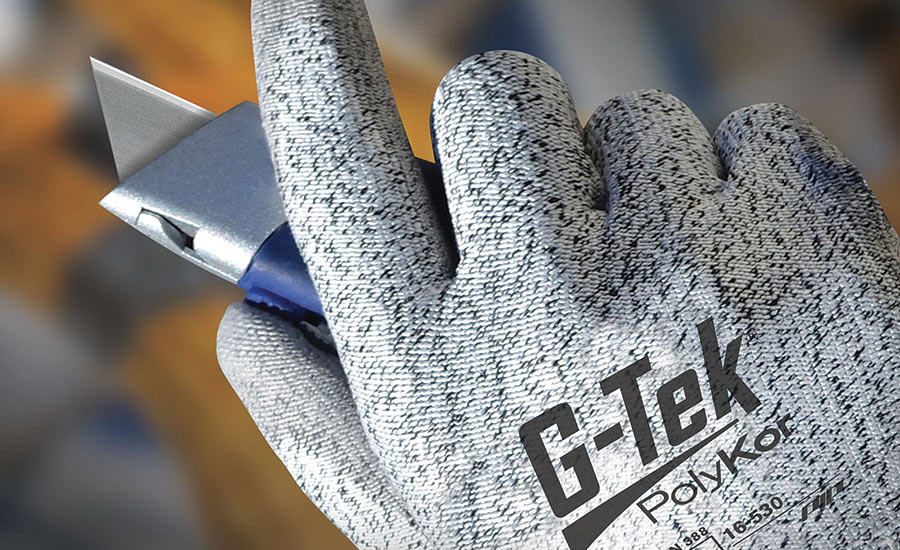I may not be a 30-year “glover” but I’ve spent most of my career in the industrial world selling or marketing safety products. I’ve been on many job sites and in factories offering workers solutions for improving efficiency and safety. During the years, it has been interesting to see how technology has aided in improving worker efficiency and comfort, while at the same time watching workers use more and more PPE. It used to be that workers would refuse to wear gloves because they were so uncomfortable that gloves would actually impede people from doing their job. I can also remember old-timers bragging about their callused and battered hands as if they were a badge of honor. This is no longer the case.
Protection and efficiency
Glove technology has advanced so quickly in the past 20 years that gloves not only protect hands, but also help increase efficiency. Coated knits offer workers snag-free protection and high tactility grip. Objects like sharp sheet metal and glass can be handled quickly and without hesitation. Disposable and chemical gloves are used by nearly everyone to ensure that hands remain clean and free of harmful liquids or contaminants. There are even impressive, task-specific gloves that offer multiple types of protection including anti-vibration palms and impact protecting TPR on the back of hand.
While it is often quoted that 70 percent of work-related hand injuries were a result of people not wearing gloves, the so-called “bare hand market” has certainly diminished dramatically over the years. More and more workers wear gloves to do the job – but are they wearing the right gloves?
Gaps in protection
Market data tells us that more often than not, the gloves do not offer adequate protection for the task.
The most obvious example would be gloves rated for cut protection. While we’d like to think that glove ratings could be equated to specific occupations, it is just not the case. Gloves are task- and condition-specific
Other common applications include the handling of small- and medium-sized parts. Again, if the parts are sharp, cut protection is a must. But dexterity and tactile sensitivity becomes a very important factor as well. It is vital for customers to handle parts securely, quickly and with confidence. Comfort, fit and form are imperative, and it is often difficult to identify which gloves provide all three, while allowing the worker to do his job. All gloves pretty much look the same when they’re in the bag, but they are not. Let’s take some time to explore what makes a good quality glove.
Attention to detail
It’s crucial to choose a breathable glove when handling parts in dry or slightly oily conditions. Back of the hand breathability is a given when talking about the knit liner, however, it is not so obvious when dealing with the coating. Depending on the coating, you can have a smooth surface that is completely impermeable or a foam type that allows air channels to pass through, while inhibiting oil or wetness from entering. The cells on the surface actually act as suction cups that help grip and channel wetness or oil away. Gloves with foam coatings are more comfortable than textured or smooth-surfaced coatings, which may not be breathable. Simply put, attention to detail in regard to coatings can make a huge improvement in the application where gloves are used.
Coated knit gloves offer protection classified as cut-resistant or general purpose. Most of the time, buyers opt for general purpose gloves because the threat of laceration may not be obvious or serious. The fact is, we wear gloves for protection and unless it’s protection from liquid contamination, we are generally protecting our skin from damage caused by cuts or abrasions. Even if someone is handling boxes in a warehouse, there’s still a real chance of being cut. Whether it’s from scraping against a sharp shelf or catching a falling object, many manual tasks present the threat of cuts.
From general purpose to general protection
So instead of “General Purpose,” we should be demanding “General Protection” gloves for all workers. That means that some level of cut protection should be required. One would think that doing this would quadruple budgets for gloves, but we can state confidently that this is no longer the case.
Imagine for a minute the amount of hazards on a construction job site. With so many varied tasks, a “one-glove-protects-all” approach is possible with General Protection gloves using engineered yarns. Advances in proprietary engineered yarns can deliver cut protection at a fraction of what it costs only a few years ago. With General Protective gloves made of new engineered yarns, workers can be confident that their hands are truly protected. Buyers and safety managers no longer need to make judgement calls based on which tasks need cut protection and which don’t. With fewer styles of gloves needed to supply, the overall cost of protecting the workers can come down.
The advancement in new technology-driven engineered yarns takes protection to a new level. Consider these gloves against the history of gloves classified as general purpose or mechanical protection.


